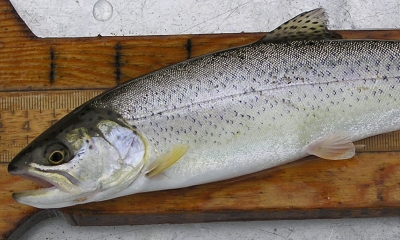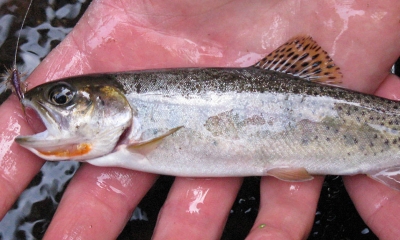
Cutthroat trout
These trout are named for the red-orange slashes on the underside of the lower jaw.

Types of Cutthroat trout

Features: Coastal cutthroat trout are typically are blue/green on top, red along the lateral line, and white on the belly. They are lightly or heavily spotted and adults have a red slash mark on the throat.
Habitat: The most common variety of trout in Oregon is the coastal cutthroat, found in the streams and beaver ponds in coastal drainages. They also are stocked in high mountain hike-in lakes where the water stays cool throughout the summer.
Techniques: Cutthroats that are year-round residents of small streams may not get any bigger than 8- or 9-inches, but can reward the angler with an aggressive bite and enthusiastic fight. Bait is not generally allowed on coastal streams above tidewater, but these feisty fish respond well to spinners, flies and other artificial lures.
Header photo by Michael Gray, ODFW

Features: The name “cutthroat” is derived from the two red slash marks or streaks on the underside of the lower jaw. Lahontans don't develop the intense crimson or gold coloration that other subspecies do, but the males can develop some red on their sides. Spots on the head can help distinguish this subspecies from other inland cutthroat subspecies.
Habitat: This variety has adapted to the dry, highly alkaline waters and was once widespread throughout the Lahontan Basin of California, Nevada and southeast Oregon. Today, native populations can be found in the Whitehorse and Willow creek basins in the far southeastern part of the state.
Techniques: Most anglers will encounter Lahontans in places where they have been stocked, such as Mann Lake at the base of the Steens Mountain. There, these trout can grow to be 20-inches long or more. Fish this big primarily feed on smaller fish, so flies and lures that mimic small fish work well.
Features: While in the sea, sea-run cutthroat feed on crustaceans and small fish and can grow up to one inch a month. By the time they return to fresh water to spawn, these fish can be up to 18-inches long and are bright silver, much like a small steelhead.
Habitat: This is a sea-run strain of the coastal cutthroat that travels into the saltwater estuaries for a few months of the year. Unlike salmon and steelhead, sea-run trout don’t migrate far from their home river and return to freshwater in late summer – July and August.
Technique: Sea-run cutthroat trout are more predatory than their resident cousins and anglers often target them with lures and flies that mimic small fish.

Features: Like all cutthroat trout, this species boasts bright red streaks on either side of its “throat.” You can tell it’s a westslope cutthroat by its spot pattern – the majority of the black spots are found on the back end of the fish with rather few ahead of the dorsal fin.
Habitat: While westslope cutthroat trout was once the most widely distributed cutthroat in North America, its home in Oregon has always been limited to the John Day Basin. During the cooler months of summer you can find them in places like Strawberry Creek and upper Canyon Creek. As temperatures drop in the fall, the fish will drop lower in the system to the mainstem, where access is more limited as most fish will be found on private land.
Techniques: These fish feed on aquatic and terrestrial insects – food sources that can be mimicked well by flies and artificial lures. Bait is prohibited in most streams in the Northeast Zone.
Header photo by Kirk Handley

